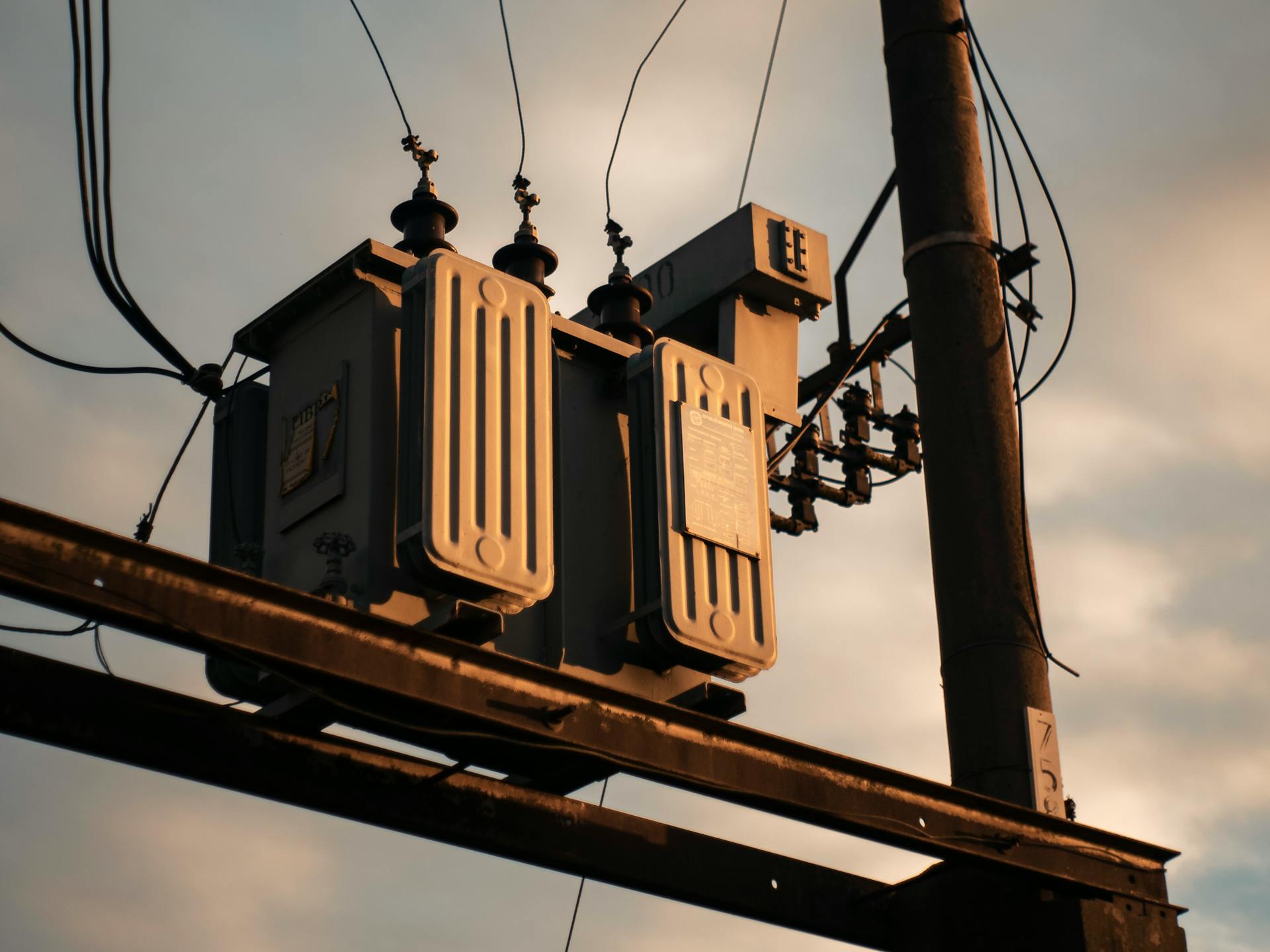
The Hugging Face Transformer is a game-changer in the world of natural language processing (NLP). It's a pre-trained language model that can be fine-tuned for a wide range of tasks.
The Transformer architecture was first introduced in 2017 by Vaswani et al. in their paper "Attention is All You Need". This paper revolutionized the field of NLP by proposing a new approach to sequence-to-sequence tasks that relied solely on self-attention mechanisms.
The Hugging Face Transformer is built on top of this architecture and has been widely adopted in the industry due to its simplicity and effectiveness. It's a great example of how research can be translated into practical applications.
One of the key benefits of the Hugging Face Transformer is its ability to handle long-range dependencies in language, making it particularly well-suited for tasks like question answering and text classification.
Transformers
Transformers is the main library by Hugging Face, providing intuitive and highly abstracted functionalities to build, train, and fine-tune transformers.
It comes with almost 10,000 pre-trained models that can be found on the Hub, making it a treasure trove for developers. These models can be built in Tensorflow, Pytorch, or JAX, giving users flexibility in their choice of framework.
Anyone can upload their own model to the Hub, further expanding the library's capabilities and community-driven growth.
Suggestion: How to Use Models from Huggingface
Getting Started
More than 61,000 developers have already jumped on the Hugging Face transformers bandwagon, and it's easy to see why - its community is almost 30,000-strong and growing.
You'll need to prepare your data to use Hugging Face transformers, but don't worry, it's not as daunting as it sounds.
Data scientists spend a whopping 39% of their time on data preparation and cleansing, according to Anaconda's 2021 State of Data Science survey.
To avoid human error and save time, consider establishing a pipeline that can automatically process your data for you.
Qwak is a leading ML platform that enables teams to take their models and transform them into well-engineered products, removing friction from ML development and deployment.
Transformers in Action
The Hugging Face ecosystem is a powerful tool for text generation, and we can see it in action with GPT-2, a model that's still well-suited for many applications.
To get started, you'll need to set up a virtual environment and install the transformers and tokenizers library, which can be done using virtualenv.
Hugging Face libraries make text generation easy, as demonstrated by the simple text generation demo based on examples from their blog and documentation.
The text generated by GPT-2 can repeat indefinitely, but we can integrate beam search and a penalty for repetition to make the output more sensible.
Beam search works by following several probable text branches along with the most likely token sequences before it settles.
By using no_repeat_ngram_size to penalize repetitive sequences, the model produces a piece of text that's more like something a human might write.
In fact, with this approach, the output becomes more coherent and less repetitive, making it a great solution to the repetition problem.
A unique perspective: Llama 2 Huggingface
Transformers

Transformers is the main library by Hugging Face, providing intuitive and highly abstracted functionalities to build, train, and fine-tune transformers.
It comes with almost 10,000 pre-trained models that can be found on the Hub, making it a great resource for anyone looking to get started with transformers.
These models can be built in Tensorflow, Pytorch, or JAX, a very recent addition to the library.
Anyone can upload their own model to the Hub, expanding the library's capabilities and making it even more useful.
The transformers library is incredibly versatile, and we'll be diving deeper into its main classes and features alongside our example code.
The training loop can be passed the data collator as an argument, which we'll cover in more detail later.
You can find the entire code in our Github repository, making it easy to follow along and experiment with the library.
For a more complete introduction to Hugging Face, check out the Natural Language Processing with Transformers: Building Language Applications with Hugging Face book by 3 HF engineers.
Expand your knowledge: Ollama Huggingface
Auto Classes
Auto classes are a game-changer for finding the right model or tokenizer for your problem.
Auto classes can simplify the process of loading a pretrained model from the model hub, like the DeiT model from facebook/deit-base-distilled-patch16-224.
With an autoclass, you don't need to know the corresponding model type, it will automatically retrieve the relevant model with the right weights.
This can be especially useful when working with complex models like DeiTForImageClassification.
Using an autoclass, you can load a model like DeiTForImageClassification with just a few lines of code, no need to specify the model type.
Auto classes can also be extended to tokenizers and feature extractors, making your workflow even more efficient.
Extra Features
The transformers library has a lot to offer beyond its core functionality.
One extra feature I find very helpful is the ability to mention a few extra features.
This library is packed with useful tools that can make your work easier and more efficient.
The transformers library is a great resource for anyone looking to work with transformers.
One of the most useful extra features is the ability to finally take this opportunity to mention a few extra features.
Hugging Face Ecosystem
The Hugging Face ecosystem is built around attention-based transformer models, with its transformers library at the core.
Hugging Face's transformers library requires a tokenizer to convert text sequences into vectors, matrices, and tensors that the model can understand.
The Hugging Face ecosystem also includes the accelerate library, which enables distributed training with hardware acceleration devices like GPUs and TPUs, making it easy to scale up training scripts.
A dedicated community, the Hugging Face Hub, supports all of Hugging Face's libraries and provides tools for versioning and hosted inference through its API.
Here's an interesting read: Distributed Training Huggingface
Hugging Face Ecosystem
The Hugging Face ecosystem is built around attention-based transformer models, with its transformers library at the core, supported by datasets and tokenizers libraries.
At the heart of these models is the need to convert text sequences into vectors, matrices, and tensors, which is where tokenizers come in - they're a crucial component of the Hugging Face transformer ecosystem and its pipelines.
Consider reading: How to Use Huggingface Models in Python
Hugging Face's accelerate library integrates with existing training flows and PyTorch scripts to enable distributed training with hardware acceleration devices like GPUs and TPUs.
The same training script can be used on a dedicated training run with multiple GPUs or on a laptop CPU, thanks to the accelerate library.
A dedicated community, the Hugging Face Hub, supports all of Hugging Face's libraries and adds value to projects with tools for versioning and an API for hosted inference.
The Hugging Face Hub is a valuable resource for creating and sharing community resources, making it easier to deploy AI in production.
Worth a look: How to Run Accelerate Huggingface
Install Required Packages
To get started with the Hugging Face Ecosystem, you'll need to install some required packages. PyTorch is a prerequisite for using the Hugging Face transformers library.
You can install PyTorch by running a command in your SingleStore Notebook. First, you'll need to install the transformers library from Hugging Face using pip.
PyTorch needs to be installed before you can use the transformers library.
After installing, you may need to restart the SingleStore Notebook kernel to ensure that the newly installed packages are recognized.
Load Pre-Trained Model and Tokenizer
Loading a pre-trained model and its corresponding tokenizer is a crucial step in using the Hugging Face ecosystem. This can be done using the function from_pretrained('model_name'), which will instantiate the selected model and assign the trainable parameters.
The model is by default in evaluation mode, so we need to execute model.train() in order to train it. This is a key step in preparing the model for use.
Hugging Face's transformers library supports loading pre-trained models, and each model comes with its own tokenizer based on the PreTrainedTokenizer class. This is a core component of the Hugging Face transformer ecosystem and its pipelines.
The Hugging Face Hub is a dedicated community that creates and shares community resources, including tools for versioning and an API for hosted inference. This adds value to projects and makes it easier to use pre-trained models and tokenizers.
To load a pre-trained model and tokenizer, we can use the distilbert-base-uncased-finetuned-sst-2-english model for sentiment analysis, as shown in the example. This model is a good starting point for many NLP tasks.
Worth a look: Huggingface Tokenizer Pad
Frequently Asked Questions
What is the introduction to Hugging Face models?
Hugging Face is a large open-source community that provides tools for building, training, and deploying machine learning models. It enables users to share and collaborate on models, datasets, and tools, making it easier to develop and deploy AI projects.
What are Hugging Face transformers used for?
Hugging Face Transformers are used for deep learning tasks, enabling users to leverage state-of-the-art pre-trained models for improved performance. They provide a powerful tool for fine-tuning and customizing these models to suit specific needs.
What is the difference between Hugging Face and transformers?
Hugging Face is a library that provides a hub for integrating machine learning models, while Transformers is a specific library within Hugging Face that offers state-of-the-art models and a Trainer API for training. Think of Hugging Face as the platform, and Transformers as a key tool within it.
When was transformer architecture introduced?
Transformer architecture was introduced in 2017 by Vaswani et al. in a groundbreaking paper that revolutionized AI research and applications.
Sources
Featured Images: pexels.com


